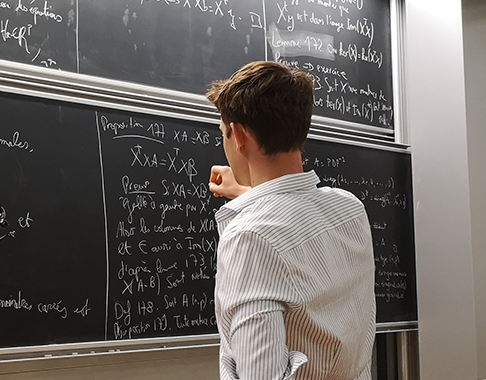Empirical Industrial Organization
Enseignant
MOLINA Hugo
Département : Economics
Crédits ECTS :
4
Heures de cours :
24
Heures de TD :
0
Langue :
Anglais
Modalité d'examen :
mém+CC
Objectif
The aim of the course is to give a solid grounding in the modern empirical tools that are useful in understanding the structure of markets, and the strategic behavior of firms and their consumers. The course covers discrete choice and static demand estimation, the estimation of market power and firm conduct, and the analysis of horizontal mergers and vertical relations (including manufacturer-retailer bargaining).
Grading
Students are expected to prepare for and actively participate in all lectures and computer sessions. The grade for this course is based on presentations of papers (30%) and a final home assignment (70%).
Plan
The course is organized as follows: ? Market with homogeneous products. (2h00) Study the basic estimation challenges of demand and supply. ? Demand for differentiated products. (6h00) Review standard demand models for differentiated products (logit, nested logit). Study the more flexible random coefficient logit model. Analyze what can be learned from micro data. ? Market power and models of firm behavior (4h00) Estimation of market power. Estimation of firm conduct: how to infer whether firms compete or collude?
? Horizontal mergers. (6h00) Analyze the effect of mergers when firms compete in quantity/price. Learn how to estimate the effect of mergers using program evaluation methods. Simulate the effect of mergers using a model of competition. ? Contracts, bargaining, and vertical structures. (6h00) Study how different forms of vertical contracts impact the market outcomes. Estimation of market power in vertical markets (bargaining between manufacturers and retailers). There will be a problem set on ?, ?, and ? after October.
Meeting 1:
- Topic 1: Introduction to Empirical IO and Markets with Homogeneous Products.
Meeting 2:
- Topic 2 (part 1): Static Demand Estimation
Meeting 3:
- Topic 2 (part 2): Static Demand Estimation
Meeting 4:
- Topic 3 (part 1): Market Power
Meeting 5:
- Topic 3 (part 2): Firm Conduct
Meeting 6:
- Topic 4 (part 1): Horizontal Mergers
Meeting 7:
- Topic 4 (part 2): Horizontal Mergers
Meeting 8:
- Topic 5: Vertical Relations
Références
Introduction to Empirical IO
- Ackerberg, Daniel, C. Lanier Benkard, Steven T. Berry, and Ariel Pakes. 2007. ‘‘Econometric Tools for Analyzing Market Outcomes." Handbook of Econometrics, 6, 4171-4276.
- Reiss, Peter C. and Frank A. Wolak. 2007. ‘‘Structural Econometric Modeling: Rationales and Examples from Industrial Organization." Handbook of Econometrics, 6, 2007, 4277–4314.
- Aguirregabiria, Victor. 2021. ‘‘Empirical Industrial Organization: Models, Methods, and Applications." Book in progress.
- Verboven, Frank. 2012. ‘‘Empirical Industrial Organization and Competition Policy." Book in progress.
Static demand estimation
- Berry, Steven T. 1994. ‘‘Estimating Discrete-Choice Models of Product Differentiation." RAND Journal of Economics, 25(2), pp. 242-262.
- Berry, Steven T., James Levinsohn, and Ariel Pakes. 1995. ‘‘Automobile Prices in Market Equilibrium." Econometrica, 63, pp. 841–990.
- Berry, Steven T., James Levinsohn, and Ariel Pakes. 2004. ‘‘Differentiated Products Demand Systems from a Combination of Micro and Macro Data: The New Car Market." Journal of Political Economy, 112, pp. 68–105.
- Berry, Steven T. and Philip Haile. 2021. ‘‘Foundations of Demand Estimation." Handbook of Industrial Organization, 4(1), pp. 1-62. Elsevier.
- Train, Kenneth. 2009. ‘‘Discrete Choice Methods with Simulation." Cambridge University Press.
Market Power and Firm Conduct
- Bresnahan, Timothy F. 1982. ‘‘The Oligopoly Solution Concept Is Identified." Economics Letters, 10(1-2), 87-92.
- Gandhi, Amit, and Aviv Nevo. 2021. ‘‘Empirical Models of Demand and Supply in Differentiated Products Industries." Handbook of Industrial Organization, 4(1), pp. 63-139. Elsevier.
- Nevo, Aviv. 1998. ‘‘Identification of the Oligopoly Solution Concept in a Differentiated-Products Industry." Economics Letters, 59(3), 391-395.
- Nevo, Aviv. 2001. ‘‘Measuring Market Power in the Ready-to-Eat Cereal Industry." Econometrica, 69(2), 307–342.
Horizontal Mergers
- Angrist, Joshua D., and Jörn-Steffen Pischke. 2010. ‘‘The Credibility Revolution in Empirical Economics: How Better Research Design Is Taking The Con Out Of Econometrics.'' Journal of Economic Perspectives, 24(2), 3-30.
- Asker, John, and Volker Nocke. 2021. ‘‘Collusion, Mergers, and Related Antitrust Issues.'' Handbook of Industrial Organization, 5(1), pp. 177-279. Elsevier.
- Björnerstedt, Jonas, and Frank Verboven. 2016. ‘‘Does Merger Simulation Work? Evidence from the Swedish Analgesics Market.'' American Economic Journal: Applied Economics, 8(3), 125-164.
- Miller, Nathan H., and Weinberg, Matthew C. 2017. ‘‘Understanding the Price Effects of the MillerCoors Joint Venture.'' Econometrica, 85(6), 1763-1791.
- Nevo, A., & Whinston, M. D. (2010). ‘‘Taking the Dogma Out of Econometrics: Structural Modeling and Credible Inference.'' Journal of Economic Perspectives, 24(2), 69-82.
Vertical Relations
- Lee, Robin S., Michael D. Whinston, and Ali Yurukoglu. 2021. ‘‘Structural Empirical Analysis of Contracting in Vertical Markets." Handbook of Industrial Organization, 4(1), pp. 673-742. Elsevier.
- Villas-Boas, Sofia Berto. 2007. ‘‘Vertical Relationships Between Manufacturers and Retailers: Inference with Limited Data." Review of Economic Studies, 74(2), 625-652.










